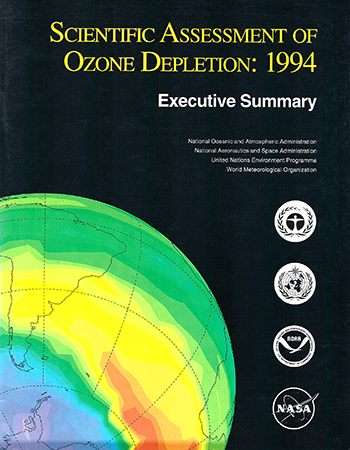Scientific Assessment of Ozone Depletion: 1994
Preface

The present document contains key summaries from the Scientific Assessment of Ozone Depletion: 1994. The full assessment report will be part of the information upon which the Parties to the United Nations Montreal Protocol will base their future decisions regarding protection of the stratospheric ozone layer.
Specifically, the Montreal Protocol on Substances That Deplete the Ozone Layer states (Article 6): ". . . the Parties shall assess the control measures . . . on the basis of available scientific, environmental, technical, and economic information." To provide the mechanisms whereby these assessments are conducted, the Protocol further states: ". . . the Parties shall convene appropriate panels of experts" and "the panels will report their conclusions . . . to the Parties."
Three assessment reports have been prepared during 1994 to be available to the Parties in advance of their meeting in 1995, at which they will consider the need to amend or adjust the Protocol. The two companion reports to the scientific assessment focus on the environmental and health effects of ozone layer depletion and on the technology and economic implications of mitigation approaches.
The scientific assessment summarized in the present document is the latest in a series of seven scientific reports prepared by the world's leading experts in the atmospheric sciences and under the international auspices of the World Meteorological Organization (WMO) and the United Nations Environment Programme (UNEP). The chronology of those scientific assessments and the relation to the international policy process are summarized as follows:
| Year | Policy Process | Scientific Assessment |
|---|---|---|
| 1981 | The Stratosphere 1981 Theory and Measurements. WMO No. 11. | |
| 1985 | Vienna Convention | Atmospheric Ozone 1985. 3 vol. WMO No. 16. |
| 1987 | Montreal Protocol | |
| 1988 | International Ozone Trends Panel Report 1988. 2 vol. WMO No. 18. | |
| 1989 | Scientific Assessment of Stratospheric Ozone: 1989. 2 vol. WMO No. 20. | |
| 1990 | London Amendment | |
| 1991 | Scientific Assessment of Ozone Depletion: 1991. WMO No. 25. | |
| 1992 | Methyl Bromide: Its Atmospheric Science, Technology, and Economics (Assessment Supplement). UNEP (1992). | |
| 1992 | Copenhagen Amendment | |
| 1994 | Scientific Assessment of Ozone Depletion: 1994. WMO No. 37. | |
| (1995) | Vienna Amendment (?) |
The genesis of Scientific Assessment of Ozone Depletion: 1994 occurred at the 4th meeting of the Conference of the Parties to the Montreal Protocol in Copenhagen, Denmark, in November 1992, at which the scope of the scientific needs of the Parties was defined. The formal planning of the present report was a workshop that was held on 11 June 1993 in Virginia Beach, Virginia, at which an international steering group crafted the outline and suggested scientists from the world community to serve as authors. The first drafts of the chapters were examined at a meeting that occurred on 2 - 4 March 1994 in Washington, D.C., at which the authors and a small number of international experts improved the coordination of the text of the chapters.
The second draft was sent out to 123 scientists worldwide for a mail peer review. These anonymous comments were considered by the authors. At a Panel Review Meeting in Les Diablerets, Switzerland, held on 18 - 21 July 1994, the responses to these mail review comments were proposed by the authors and discussed by the 80 participants. Final changes to the chapters were decided upon, and the Executive Summary contained herein was prepared by the participants.
The group also focused on a set of questions commonly asked about the ozone layer. Based upon the scientific understanding represented by the assessments, answers to these common questions were prepared and are also included here.
As the accompanying list indicates, the Scientific Assessment of Ozone Depletion: 1994 is the product of 295 scientists from the developed and developing world1 who contributed to its preparation and review (230 scientists prepared the report and 147 scientists participated in the peer review process).
What follows is a summary of their current understanding of the stratospheric ozone layer and its relation to humankind.
1. Participating were Argentina, Australia, Austria, Belgium, Brazil, Canada, Chile, Cuba, Czech Republic, Denmark, Egypt, France, Germany, Greece, Hungary, India, Iran, Ireland, Israel, Italy, Japan, Kenya, Malaysia, New Zealand, Norway, Poland, Russia, South Africa, Sweden, Switzerland, Taiwan, The Netherlands, The People's Republic of China, United Kingdom, United States of America, and Venezuela.